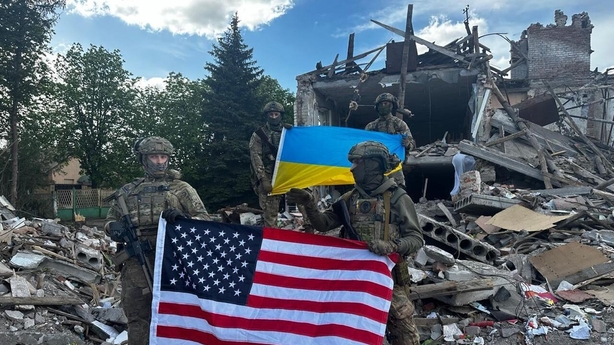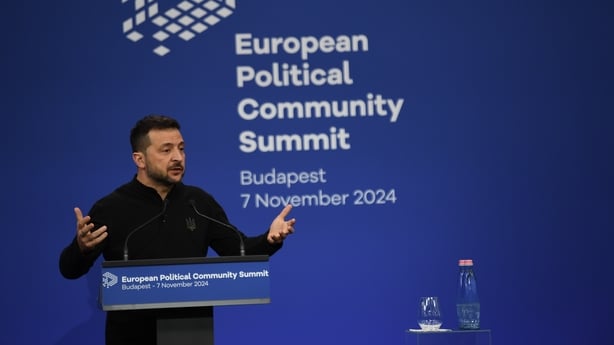Sergeant Sarah Ashton-Cirillo remembers the day last April when the US Congress passed a long-awaited $61bn military aid package for Ukraine.
The American journalist turned sergeant in the Ukrainian defence forces had been visiting a position on the Donetsk front.
"I was at the front in an area of operations with Ukraine's Fifth Assault Brigade. And I remember that moment because the guys from the fifth were so ecstatic," Sgt Ashton-Cirillo, speaking from Kyiv, told RTÉ News.
The soldiers posed for a photo holding the stars and stripes on the site of a destroyed crèche.
But restrictions placed by the US on how some of that lethal aid is used dampened that enthusiasm in recent months.
"There’s incredible frustration among our commanders and among those who operate the different systems that we're not allowed to use these US systems to maximum capacity and full efficiency.
"Nonetheless, having them at our disposal has guaranteed Ukraine's sovereignty thus far," she said.
Describing herself as a "centrist Democrat", she said there was "cautious optimism" among her fellow soldiers about what the incoming Trump administration will mean for Ukraine.

$61bn US military aid package last April (Courtesy: Sgt. Sarah Ashton-Cirillo)
Since Russia's full-scale invasion in February 2022, the US has provided more than $100bn in aid packages to Ukraine, almost $70bn of which has been military aid.
But there has been a limit to that solidarity.
The Biden administration has feared escalation with Russia, providing vital weapons and ammunition to Ukraine's armed forces but limiting the use of long-range weaponry to strike Russian targets within Russia.
This has led some Ukrainian policy experts to believe that a continuation of the Biden policy on long-range weapons would eventually lead to Ukraine's defeat.
Donald Trump’s return to the White House from January now casts doubt over what kind of military aid, if any, the US will provide Ukraine.
Senate Republicans spent the start of this year blocking the $61bn military aid package that Ukrainian soldiers celebrated along the frontlines that day in April.
During the election campaign, Mr Trump said very little about Ukraine, except that he would end the war in a day. However, he has given no details on how exactly he would do that.
In an interview with Fox News in July, he said that he would withhold aid from Ukraine as a way of getting Kyiv to join peace talks. Equally, he said that if Russia refused to join talks, the US would, in turn, provide greater aid to Kyiv.
Mr Trump’s running mate, Vice President-elect JD Vance, has had plenty to say about Ukraine, namely that his chief's plan to end the war includes the establishment of a demilitarised zone.
Creating such a zone along the current 1,300km frontline would mean Ukraine effectively agreeing to freeze the conflict. Russia, in turn, would try to use the deal to retain control over 20% of Ukraine’s territory indefinitely.
Then there is the question around how the massive zone would be policed. Neither the US, nor most European countries would like that role as it would risk drawing them directly into a future war.
Mr Vance said in an interview just days before the start of Russia’s all-out invasion that he didn’t "care what happens to Ukraine, one way or the other". On the basis of those statements, future US support for Ukraine looks shaky.

not discussed Donald Trump's peace plan with him.
But there are signs that the incoming Trump administration may not spell such a bleak outcome for Ukraine.
In 2017, the previous Trump administration approved sending a small amount of lethal aid to Ukraine. The previous Obama administration had stuck to providing Kyiv with non-lethal aid even after Russia’s illegal annexation of Crimea and the start of its proxy war in eastern Ukraine since 2014.
Last June, Mr Trump also rejected Russian President Vladimir Putin’s demands to end the war which include guarantees that Ukraine will drop its request to join NATO and that its forces withdraw from territory occupied by Russia.
"Trump is riskier but it's not necessarily a negative connotation," Oleksandr Kraiev, a Ukrainian foreign policy expert, told RTÉ News.
"He’s always saying the same thing, that he wants to end the war as quickly as possible with no regard to results, with no regard to a particular peace plan," said Mr Kraiev who heads the North America program at Prism, a Kyiv-based thinktank.
He believes that Mr Trump's main goal with Ukraine is to get negotiations started.
"It’s not to achieve some kind of a stable peace, but to achieve a ceasefire, and then just to protract this ceasefire as long as possible, and maybe still continue to support Ukraine with weapons," said Mr Kraiev.
However, getting Russia to the negotiating table poses a challenge for Mr Trump and his incoming administration.
Mr Putin shows no motivation to end the war that he began 32 months ago. Over the past six months, Russian forces have intensified their attacks along the front, gaining small slivers of territory along the way.
Russia continues to fire up to ten times more shells each day than Ukraine. In short, the war is slowly going in Russia's direction despite its forces incurring up to 30,000 casualties each month, according to estimates by the UK ministry of defence.
Without any opposition in Russia, Mr Putin can continue to sustain those horrific loses and wage the war at the same pace.

"Trump will try to make some sort of a compromise deal with the Russians. That will be quite painful for Ukraine, but he will look to end the war," Peter Dickinson, editor of the Atlantic Council's Ukraine Alert blog, told RTÉ News.
Speaking from Kyiv, Mr Dickinson said Ukraine is unlikely to officially cede any of its territory but could potentially agree to a deal whereby it accepts the current status quo in return for security guarantees.
"I think the key issue really is the level of security guarantees or commitments that Ukraine is able to secure from America and the West within the framework of any deal," he said.
That security guarantee may fall short of NATO membership, however.
During Mr Trump's first presidency, he spoke of the US achieving "peace though strength" and, in this campaign, his running mate JD Vance talked up that policy.
Many Ukrainian analysts are interpreting this as a sign that the new Trump administration will first look to bolster Ukraine's defensive capabilities in a bid to force Mr Putin to the negotiating table.
The morning after Mr Trump's election victory, Ukrainian President Volodymr Zelensky commended Mr Trump for his "peace through strength" approach to global affairs. Mr Zelensky again used the term in Budapest on Thursday when he spoke to other European leaders at the European Political Community summit.
Providing more military aid to Ukraine would be good for the US economy, something that Mr Trump can advertise to Republican lawmakers - about half of whom are skeptical about continuing to fund Ukraine.
But that money goes to the US defence industry and the American arm manufacturers producing weapons and ammunition for Ukraine.
The first few months of Mr Trump's second presidency are likely to be consumed with domestic affairs as he goes about trying to reshape the department of justice and, if he follows through on his campaign rhetoric, hounding his political opponents.
But after that, Ukraine should move higher up the list of priorities.
The first step from the new Trump administration, said Mr Dickinson, will likely be an attempt to strengthen Ukraine's position.
"The next step would be to look to sit down with the Russians and begin talks," he said.
A Kremlin spokesperson said yesterday that Mr Putin would be open to talking to Mr Trump, an early signal that Russia could move towards talks in the months ahead.







